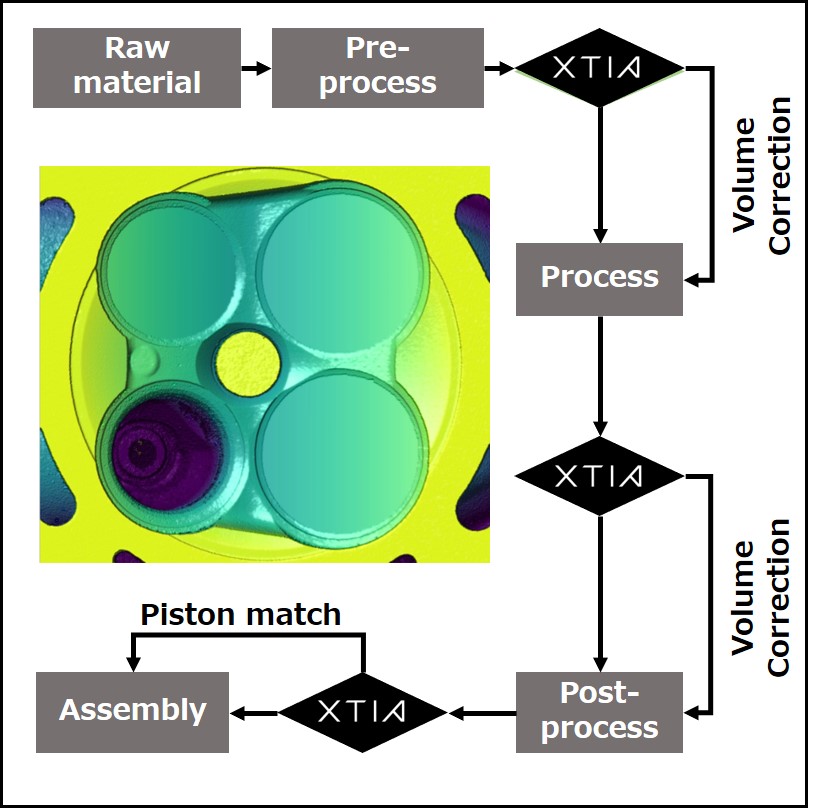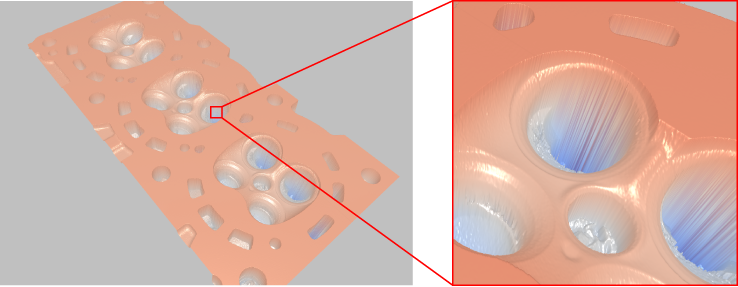


High-accuracy detection of process variations for process correction.
3D measurement of coaxial optical systems using our optical comb technology can obtain 3D profiles with high accuracy and no blind spots, even for parts with complex shapes. Therefore, by introducing this 3D measurement in the middle of the manufacturing process flow, correction machining can be performed based on that information, making it possible to reduce geometric tolerances in the design. Our solution creates significant added value.
> Measure whether the volume of the cylinder block is as designed.
> Reduction of geometric tolerances
> A solution to achieve volume calculation with high accuracy was not found.
> Realization of 100% inspection
> Automatic 3D measurement of all cylinder heads and calculation of chamber volume with high accuracy
> Achieved improved fuel efficiency through "aggressive design" that enables correction processing based on the results.

Automatic volume calculation of combustion chambers with high accuracy.
The optical comb technology and our coaxial laser scanners provide access to the dimensional profile of complex structures with high accuracy. As a result, our hardware and software combined solutions can be extremely valuable if integrated within the manufacturing process flow, because it opens the door to the reduction of geometric tolerances by a specific correction process. Geometric tolerance is defined as the amount of variation that can be tolerated, taking into account the capabilities of the manufacturing process. Nowadays, the quest for higher performance and aggressive designs in all manufactured products has led to one of the biggest challenges in product design and manufacturing: how to reduce this variation. With a fully automated inspection of all manufactured parts, the inspection data can be used to implement a correction process and significantly minimize this variation.
More specifically, with OptoComb L90 wide-range sensor, We have a proven track record in the correction of cylinder heads, an automotive component that controls fuel efficiency. In a combustion engine, the piston moves up and down inside the cylinder, and the volume generated by the upper and lower limit of this movement defines the displacement volume. As you increase the compression ratio, your car's fuel efficiency will improve. However, beyond a given limit, increasing the compression ratio leads to abnormal combustion and a knocking phenomenon is likely to occur. The key to improving fuel efficiency is thus to raise the compression ratio to a level that will prevent such abnormal combustion and subsequent reliability problems. To avoid such reliability problems while accounting for variations from cylinder to cylinder, it is thus necessary to design a safe compression ratio. Of course, with this conservative design the engine is functioning but with a suboptimal performance. To implement more aggressive designs and optimize the engine performance it is thus necessary to know the exact volume of the manufactured chamber and leverage this information to subsequently reduce the deviation through a correction process.
Optocomb 3D scanners have the unique ability to measure the full profile of such combustion chambers and extract their volume with high accuracy. In turn, this high measurement accuracy can be passed on to the correction process and we has demonstrated that volumetric variation can be reduced down to a standard deviation of less than 0.01 cc.